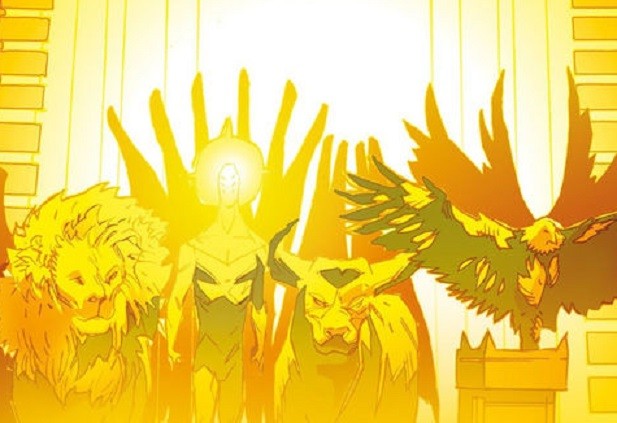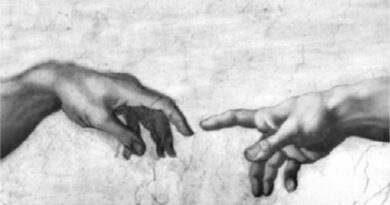
The Revelation of Jesus Christ
“The revelation of Jesus Christ, which God gave him to show his servants what must soon take place…. Blessed is the one who reads aloud the words of the prophecy, and blessed are those who hear and who keep what is written in it; for the time is near.”
Thus opens that book of the Bible which arouses the most curiosity and generates the greatest anxiety among Christians. Yet the book calls itself a blessing for those who obey. – Revelation 1:1-3
This prophecy has, perhaps, more commentary -often conflicting commentary- written on it than any other portion of the Bible. Second Peter 1:20, 21 tells us,
“First of all you must understand this, that no prophecy of scripture is a matter of one’s own interpretation, because no prophecy ever came by human will, but men moved by the holy spirit spoke from God.”
Consequently, the best interpreter of this prophecy is the Bible itself. A scriptural analysis of the book of Revelation alone would, of course, take up a volume, perhaps several. What we shall do here is consider a couple of significant points.
First, note that according to the verses quoted above the events contained in this prophecy were to “soon take place” because “the time is near”! These words were written over 1900 years ago; yet many modern commentators say that these events are still future! Should we suppose that the Creator of human language does not understand what the words soon and near mean? Even at the end of this prophecy John, who recorded it, was told,
“Do not seal up the words of the prophecy of this book, for the time is near.”
Time elements in prophecy must be given due consideration. Numbers may be symbolic or literal; but terms such as soon, near, and at hand are worthless if not understood literally. Therefore, the events depicted in this prophecy must have already taken place! – Revelation 22:10
When available, parallel passages in other portions of the Bible should be used to interpret this prophecy. Revelation 11:8 speaks of
“the great city which is spiritually called Sodom and Egypt, where their Lord was crucified.”
Where was Jesus crucified? In Jerusalem. Concerning the mysterious harlot Babylon the Great, Revelation 18:24 says,
“And in her was found the blood of prophets and of saints, and of all who have been slain in the land.” [1]
Compare this to Jesus’ words at Matthew 23:34-37,
“Therefore I send you prophets and wise men and scribes, some of whom you will kill and crucify, …that upon you may come all the righteous blood shed in the land, … Truly, I say to you, all this will come upon this generation. O Jerusalem, Jerusalem, killing the prophets and stoning those who are sent to you!”
Through this cross-referencing of Jesus’ words in Matthew with the passage in Revelation, it is shown that “The revelation of Jesus Christ, which God gave him to show his servants what must soon take place” is a prophecy concerning the fate of Jerusalem, the capital city of the covenant nation of Israel. This city was destroyed in AD 70, about 40 years after Jesus’ crucifixion. [2] This event also signified the complete abolition of the Mosaic Covenant with Israel [3] , as discussed in the book of Hebrews:
{8:1} “Now the point in what we are saying is this: we have such a high priest, one who is seated at the right hand of the throne of the Majesty in heaven, {2} a minister in the sanctuary and the true tent which is set up not by man but by the LORD… {4} Now if [Jesus] were on earth, he would not be a priest at all, since there are priests who offer gifts according to the Law. {5} They serve as a copy and shadow of the heavenly sanctuary…. {8} …The days will come, says the LORD, when I will establish a new covenant…. {13} In speaking of a new covenant He treats the first as obsolete. And what is becoming obsolete and growing old is ready to vanish away…. {9:8} By this the holy spirit indicates that the way into the [heavenly] sanctuary is not yet opened as long as the outer tent [the Temple in Jerusalem] is still standing {9} which is symbolic for the present [Mosaic] age …. {28} So Christ was once offered to bear the sins of many; and to them that wait for him he will appear the second time without sin unto salvation. {10:19} Therefore, brethren, since we have confidence to enter the [heavenly] sanctuary by the blood of Jesus, {20} by the new and living way which he opened for us through the curtain, that is, through his flesh…. {37} For yet a little while, and the coming one shall come and shall not delay…. {12:28} Therefore let us be grateful for receiving a kingdom that cannot be shaken, and thus let us offer to God acceptable worship, with reverence and awe; {29} for our God is a consuming fire.”
It may be objected that Jesus did not physically “appear” in AD 70, yet verse 9:28 says that Christ “will appear the second time without sin unto salvation”? Notice that the verse actually says “to them that wait for him he will appear.” It was with ‘eyes of faith’ that believers saw Jesus through the judgment events. Jesus’ appearance in judgment against Jerusalem in AD 70 proved him to be a true prophet; hence his sacrifice before God must have been acceptable, confirming beyond any shadow of doubt that the sins of those in the New Covenant were forgiven.
Acts 1:9-11 is often cited to prove the visible return of Christ. Some commentators see it otherwise. Let us read this passage with appropriate emphasis and interpolated comments that show this view:
“And when he [Jesus] had said this, as they [the disciples] were looking on, he was lifted up, and a cloud took him out of their sight. And while they were gazing into heaven as he went [that is, they continued gazing upward even though they could no longer see him because of the cloud] behold, two men stood by them in white robes, and said, ‘Men of Galilee, why do you stand looking into heaven [after all, you are no longer able to see him]? This Jesus, who was taken up from you into heaven, will come in the same way as you saw him go into heaven.’”
How did they see him go up into heaven? In a “cloud” which “took him out of their sight.” The cloud itself indicates invisibility. Therefore, this passage can well be used to support the invisible return of Christ!
Now let us look at the significance of clouds in the Hebrew Scriptures:
Daniel 7:13, “I saw in the night visions, and behold, one like a son of man came with the clouds of heaven, and came to the Ancient of days, and they brought him near before Him.”
Isaiah 19:1, “An oracle concerning Egypt. Behold, Yahweh is riding on a swift cloud, and will come into Egypt: and the idols of Egypt shall be moved at His presence, and the heart of Egypt shall melt in the midst of it.”
Jeremiah 4:13, “Behold, He shall come up as clouds, and His chariots as the whirl-wind: His horses are swifter than eagles. Woe unto us! for we are ruined.”
Joel 2:1, 2, “Blow the trumpet in Zion, and sound an alarm in My holy mountain! Let all the inhabitants of the land tremble; for the day of Yahweh is coming, for it is at hand: a day of darkness and gloominess, a day of clouds and thick darkness,…”
Zephaniah 1:14, 15, “The great day of Yahweh is near; it is near and hastens quickly… That day is a day of wrath, a day of trouble and distress, a day of devastation and desolation, a day of darkness and gloominess, a day of clouds and thick darkness.”
Except for Daniel 7:13, these passages show an association between clouds and God’s judgment against Israel or some other nation. Though all of these comings of God in judgment were described in apocalyptic language and brought historical calamity and/or a fall upon the nations mentioned, He acted through the means of human armies or nature to bring the destruction. These direct acts of God were termed “the day of Yahweh.” One very important factor we should note is that in all of these comings of God in the Hebrew Scriptures, God was never physically visible! Yet, in every instance, human eyes could readily see, or be aware of, His presence and decisive, personal intervention in those historical events.
At John 5:22 Jesus said,
“For neither does the Father judge any man, but he has given all judgment to the Son.”
Accordingly, in AD 70 Jesus came in judgment against Israel as reported in Revelation 1:7,
“Behold, he is coming with clouds, and every eye will see him, even they who pierced him. And all the tribes of the land [4] will mourn because of him.”
It may be objected that too much emphasis is being laid on the destruction of Jerusalem and its Temple in AD 70. However, this event was not a destruction of just another city anymore than the crucifixion of Jesus was a Roman execution of just another criminal. The fall of Jerusalem was an act of divine judgment for the murderous rejection of Jesus as God’s Son and Messiah; and for the persecution and murder of his disciples. Thus ended the covenantal relationship the nation of Israel had enjoyed with Yahweh God for approximately 1500 years.
In this very brief survey we have suggested that the biblical book of Revelation primarily deals with the judgment against apostate Israel in the first century. The time elements should not be ignored, nor explained away. Consider also that Revelation was addressed to seven Christian churches which existed in the first century. Although these churches were outside of the land of Israel, Christians and Jews throughout the Roman Empire were affected by the events transpiring there. More importantly, Jesus warned the churches against moral laxity and apostasy, and that failure to reform would lead to adverse judgment. (Revelation 2:4-5, 14-16, 20-23; 3:1-3, 14-19) Because of their spiritual decline they were in danger of ‘crucifying again the Son of God,’ and ‘holding him up to contempt.’ How does this tie in with the remainder of Revelation? If God would not spare the nation with which He had been in covenant for centuries, why should Christian churches following the same spiritual decline expect to escape adverse judgment as well? Jesus revealed the horrors of judgment through apocalyptic imagery as a stern warning to the seven churches to encourage repentance and reform. Historically, the book of Revelation applies to the first century. But the spiritual principles embedded in its message apply to all believers in every century. – Hebrews 6:6
FOOTNOTES:
[1] This is commonly translated on the earth; but in the land is contextually more accurate.
[2] It is commonly believed that the book of Revelation was written after AD 70; however, this view is not universally held. A number of scholars, both ancient and modern, believe that it was written prior to the destruction of Jerusalem. This point can be researched on the internet at preterist websites.
[3] One reason the destruction of the Mosaic kosmos (world, or order) was necessary is that many Jewish Christians had difficulty in comprehending that the sacrifices and other requirements of the Law were no longer essential for salvation. See Acts 21:18-22.
[4] “All the tribes of the land” refers to the twelve tribes of Israel. There are no ‘lost tribes.’ After the split of Israel into two kingdoms during the reign of Rehoboam, and with the turning of the northern kingdom to apostasy, faithful Israelites left the northern kingdom for the southern kingdom. (2 Chronicles 11:13-16) This is evidenced in the Christian Testament where it speaks of Anna “of the tribe of Asher.” Asher was one of the supposedly ten lost tribes. – Luke 2:36.


